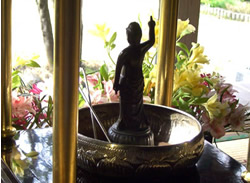 |
Hanamido |
The original Japanese Flower Festival (hana, ‘flower’, matsuri, ‘festival’) was observed to encourage fruit trees to flower; at the time, the farming community believed that the longer the blossoming, the more prosperous the harvest. Buddhism spread to Japan in the 6th century CE, and sometime around 600 CE the Hanamatsuri festival became incorporated into the celebration of the Buddha’s birthday.
A special altar—the Hanamido—is erected and decorated with flowers representing the garden in Lumbini, southern Nepal, where it is said that Queen Maya went into labour. A statue of the infant Buddha is placed in a pan and, in a ritual known as kanbutsu, water or sweet tea is poured over it in remembrance of the “sweet rain” that descended from heaven at the moment of the birth.
It is told that when Shakyamuni* was born, birds sang and flowers bloomed in honour of his arrival. Pointing with his right hand to heaven and with his left hand to earth, the newborn child took seven steps, prophesying that he would become a great sage and deliver humanity from suffering.
The kanbutsu ritual is believed to have started in China, although statues of baby Buddhas in the traditional pose—right hand pointing upwards, left down—have also been found in India. Hanamatsuri is predominately a Mahayana festival; Theravadin Buddhists observe the Buddha’s birth, enlightenment and entrance into nirvana during the festival of Wesak, held in May at the time of the full moon.